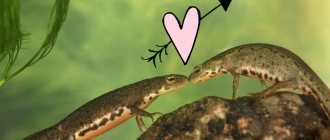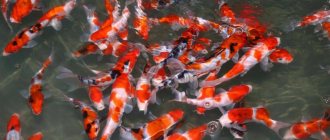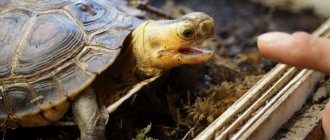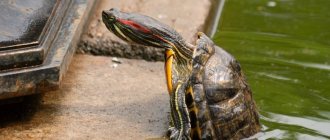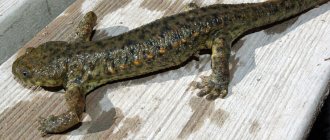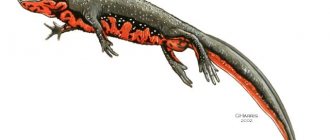Newts in the aquarium
Newts are a general designation for a group of representatives of tailed amphibians, which includes about 20 genera, which, in turn, are divided into many species and subspecies. Not all of them are suitable for keeping in a home aquarium. Let's figure out which newts can be kept in a home aquarium and what conditions are needed for this.
There are three types of newts most often kept in aquariums: common, spiny and crested.
Let's talk in more detail about each of them:
Common newt (Lissotriton vulgaris)
Common newt photo
The common newt belongs to the genus of small newts and is listed in the Red Book of Russia. Sizes from 7 to 11 centimeters, body color from olive to brown, abdomen yellowish or light orange. Sex differences are weak most of the time, males are slightly larger than females. Distinctive features become visible during the mating season - males develop a crest. The conditions for keeping it in the aquarium are as follows:
— Aquarium volume for a newt : from 15 liters, it is better, of course, more, especially if you plan to keep the newt not alone, but in a group of relatives or in the vicinity of fish. It is necessary to equip one or more islands, since newts are amphibious animals that come to land from time to time.
An ideal option would be a special Tetra ReptoAquaSet .
Aquarium for newts
And the bottomless range of REPTI-ZOO products in the attached catalog will help you in arranging your aquarium; you will find everything you need for newts: soils, islands, plants, heating pads, lamps, etc. (the catalog is huge, it takes 2-5 seconds to load, we recommend downloading it to your computer).
— Water temperature for newt. Newts are cold-water creatures. The required water temperature for keeping them is 18 - 22 degrees Celsius. And if you want to bring the newt’s living conditions as close as possible to natural ones, then to organize the wintering period, the water in the aquarium will have to be cooled to 5-8 degrees. Therefore, think about cooling the water in the aquarium in advance.
- Acidity. The pH range of newts is very wide; they live in both acidic (5.5) and almost alkaline water (7.8), but it must be remembered that, as with keeping fish, the unacceptable range of values is more important, but the stability of the indicator. Sudden changes in pH are tolerated very poorly by any living creature.
— Water hardness for Triton . They prefer either soft or medium-hard water, dH range from 5 to 15.
— Lighting for newt . The issue of lighting for the newts themselves is not fundamental, but it is still required for the vegetation in the aquarium. When designing the lighting for the newts' future home, remember that the lamp must be positioned so that it does not heat the water!
Common newt photo
— Soil for newt. The issue of soil is extremely important. Remember: you need to choose a soil fraction such that individual particles cannot fit into the newt’s mouth. Otherwise, accidental consumption of soil is possible, which will most likely lead to intestinal obstruction and death of the pet.
— Plants for newt. It is preferable to use live plants, because this makes your aquarium more natural, both aesthetically and biologically, living plants play an important role in the functioning of the nitrogen cycle in the aquarium , and if you decide to breed newts, then you cannot do without living plants at all, the female spawns in them, then tucks up the leaves, providing protection for the offspring, and the young newts hide in dense thickets.
— Filtration. Here, the recommendations for keeping fish and newts in an aquarium are the same: the filter should pump 6-10 volumes of the aquarium per hour.
— Water changes. Different sources contain different recommendations for water changes, from 15 to 30% of water per week. We think that in this case it is correct to take the average value of 20% and focus on the individual characteristics of your aquarium.
A cover glass is required, otherwise the pet may escape from the aquarium into the “big world”.
Wintering
As temperatures drop in late autumn, amphibians hibernate. Two weeks before wintering, gradually lower the temperature to 15 degrees and reduce daylight hours. Move the newts to a sphagnum moss cage in an area of identical temperature. After 3 days, place the cage with amphibians in the refrigerator. After 2 months, bring the animal out of hibernation by gradually increasing the temperature and gradually extending daylight hours.
At home, red-bellies can do without hibernation. But observing seasonal rhythms is useful, especially if you need to stimulate the reproduction of newts.
Feeding newts in the aquarium
Feeding newts
Newts are predators, they will be happy to eat small live fish, crickets, earthworms, common newt and other small species, and young newts eat frozen bloodworms well. If for some reason you cannot feed your pet live food, use pieces of lean fish, for example, haddock, cod or shrimp. Young animals are fed every day, adults 2-3 times a week. It is also recommended to occasionally give vitamin supplements and calcium supplements. Calcium supplements can be replaced with crushed eggshells, but it is better not to skimp on your pet’s health.
Food for newts Tetra
In addition to live food, it is recommended to introduce freeze-dried food from trusted brands into the newt diet. They are easy to use and contain all the necessary nutritional elements for your animal. One of the best foods is Tetra ReptoFrog Granules - a complete food for aquatic frogs and newts.
Compatibility
A species aquaterrarium is the best option. The following cannot be placed in the same container with amphibians:
- small fish and snails;
- too large predatory fish;
- crayfish;
- crabs;
- large newts;
- clawed frogs.
Red-bellies are compatible with the following neighbors:
- large shrimp;
- peaceful frogs;
- corridors;
- gourami;
- iris;
- other peaceful, medium-sized fish.
Keeping newts together with fish
Newts with fish photo
There are several problems in keeping a newt together with fish, already described above in this article:
Newts are cold-water, and most tropical aquarium fish love warm water, plus for the winter you will have to arrange a separate aquarium for the newt, because at +6 not a single tropical fish will live. The temperature of +22 is suitable for neons, but here we have a second problem...
Predator newts. And neons , as an “Amazonian snack,” are also great for them. A large goldfish can be a perfectly acceptable neighbor for a newt: it tolerates cold water well, and will not fit into its mouth even if it wants to. But it should be borne in mind that large goldfish require a completely different aquarium volume and filtration power.
Diseases of newts in the aquarium
Newts, like fish, unfortunately, sometimes get sick. They can be affected by both fungal (most often saprolegniosis and mucorosis), and parasitic and infectious diseases. A common and dangerous infectious disease of newts is the so-called “red leg”, in fact, it is sepsis, and it is called red leg because one of the symptoms is hemorrhages under the skin of the abdomen and upper parts of the legs, from which they acquire a color from pink to bright red color. Other symptoms may also include wounds on the skin; if the newt gets out of the water and dries out a little, then around the wounds you can see a black border, lethargy, even complete apathy, and refusal to eat.
The disease requires immediate treatment: if a sick newt lives with relatives, it must be isolated in a quarantine container, since the disease is contagious. Next, it is best to find a veterinary laboratory where they can do tests to understand which pathogen is responsible for the occurrence of sepsis in a particular case, so as not to poison the newt with an antibiotic to which the microbes may be insensitive. If it is not possible to perform an analysis, then there is no other way - the antibiotic will have to be selected empirically (experimentally): almost all antibiotics from the human first aid kit can be used in treatment, but most often tetracycline is used, at a dose of 50 mg/kg of animal weight through the mouth with food, aminoglycosides (amikacin, gentamicin) 20 mg/kg body weight or metronidazole (Trichopol) at a dose of 50-100 mg/kg for 5-7 days. There are also more complex methods - introducing a solution of chloraphenicol into the stomach of an amphibian through a probe. The dosage is as follows: the first administration of 8 mg of the drug in 2 ml of water, then for 6 days the administration of 4 mg of the drug in 1 ml of water, and then the prophylactic administration of a similar dose of chloraphenicol once a week for several weeks. It is possible to use medicinal baths, 15 ml of sulfadimidine solution per 10 liters of water. The duration of the bath is 1 hour, baths last for two weeks. In the event of an epidemic, complete disinfection and restart of the aquarium is necessary.
Sexual dimorphism
There are no special differences between females and males, except for size. Females are slightly larger, approximately 2 cm; males have a shorter tail, but a better developed fin. The female's tail is either equal to or longer than the body length. During breeding, the cloaca thickens in males.
The Chinese newt reaches sexual maturity 3 years after completion of metamorphosis.
Spine newt, also known as ribbed newt (Pleurodeles waltl)
Mud ribbed newt photo
The conditions for keeping the spiny newt are not much different from the ordinary one, however, it is worth considering that Pleurodeles waltl is much larger (up to 23 centimeters), accordingly, it needs a larger aquarium. Females of this species are usually larger than males, but they have a shorter tail.
Mud ribbed newt photo
When keeping this species, it should be taken into account that they have pointed ends of the ribs on their sides, which, when in danger, secrete a poisonous, very burning substance. It can damage the skin, and in some people cause an allergic reaction, even fatal, so it is better not to touch the ribbed newt with your bare hands.
Interesting Facts
Regeneration significantly extends the life of newts. They are able to restore not only lost limbs, but also eyes and even internal organs.
Some newts briefly change the color of the skin on their back from dark to light shades, while the ventral side does not change color.
Moist skin is protected by a special secretion that retains moisture inside the body and prevents pathogens from penetrating the mucous membrane and infecting the animal.
Chinese aquarium newts easily get used to their owners, are able to recognize them, and are quite smart.
Crested newt (Triturus cristatus)
Crested newt photo
In size, this is the average type of newt of the three described, they grow up to 18 cm, the body is brown to black in color, and the abdomen is orange. Very similar to the common newt, you can distinguish it by its crest. The crested newt has an intermittent crest, while the common newt has a continuous crest.
Crested newt photo
The skin of this newt has poisonous glands, the effect of the poison is similar to that of the spiny newt.
Where does it live?
The habitat of newts extends to Europe, Asia, North and South America. Most species live in temperate climates.
VARAN
Where live
The newt's natural habitat is shallow freshwater bodies of water and the surrounding area with rich vegetation. They avoid meadows, fields and other open areas. Some species are found in mountain streams and lakes located at altitudes of up to 2000 meters above sea level.
Spanish newt and confusion
Newt Spanish photo
There is a lot of confusion regarding the Spanish triton in Russia. The fact is that throughout the post-Soviet space, various species are sold under the guise of the Spanish newt. The above-described spiny (ribbed) newt Pleurodeles waltl is most often sold under the sign “Spanish newt”.
Newt Spanish photo
The real Spanish newt (Lissotriton boscai) is found exclusively on the Iberian Peninsula, Spain and Portugal, that is, it is endemic, included in the Berne Convention, protected by Spanish law, and is not found in our area at all.
All of the above is just the fruit of observing this type of amphibian and collecting various information from owners and breeders. We would like to share with visitors not only information, but also live emotions that allow us to understand the world of aquariums more fully and subtly. Register at https://fanfishka.ru/forum/ , participate in discussions on the forum, create profile topics where you will talk about your pets in the first person and first-hand, describe their habits, behavioral features and content, and share with us your successes and joys, share your experiences and learn from the experiences of others. We are interested in every bit of your experience, every second of your joy, every awareness of a mistake, which makes it possible for your comrades to avoid the same mistake. The more of us there are, the more pure and transparent drops of goodness there are in the life and everyday life of our seven billion society.
Author of the article: Mikhail Okatiev Astario
Reviews
Aquarists say Chinese red-bellied newts are very interesting to watch. Caring owners share their experience, noting that there is a lot of conflicting information about the optimal water parameters for a pet. The inhabitants of the forums agree that temperatures above 24 degrees are undesirable for newts.
